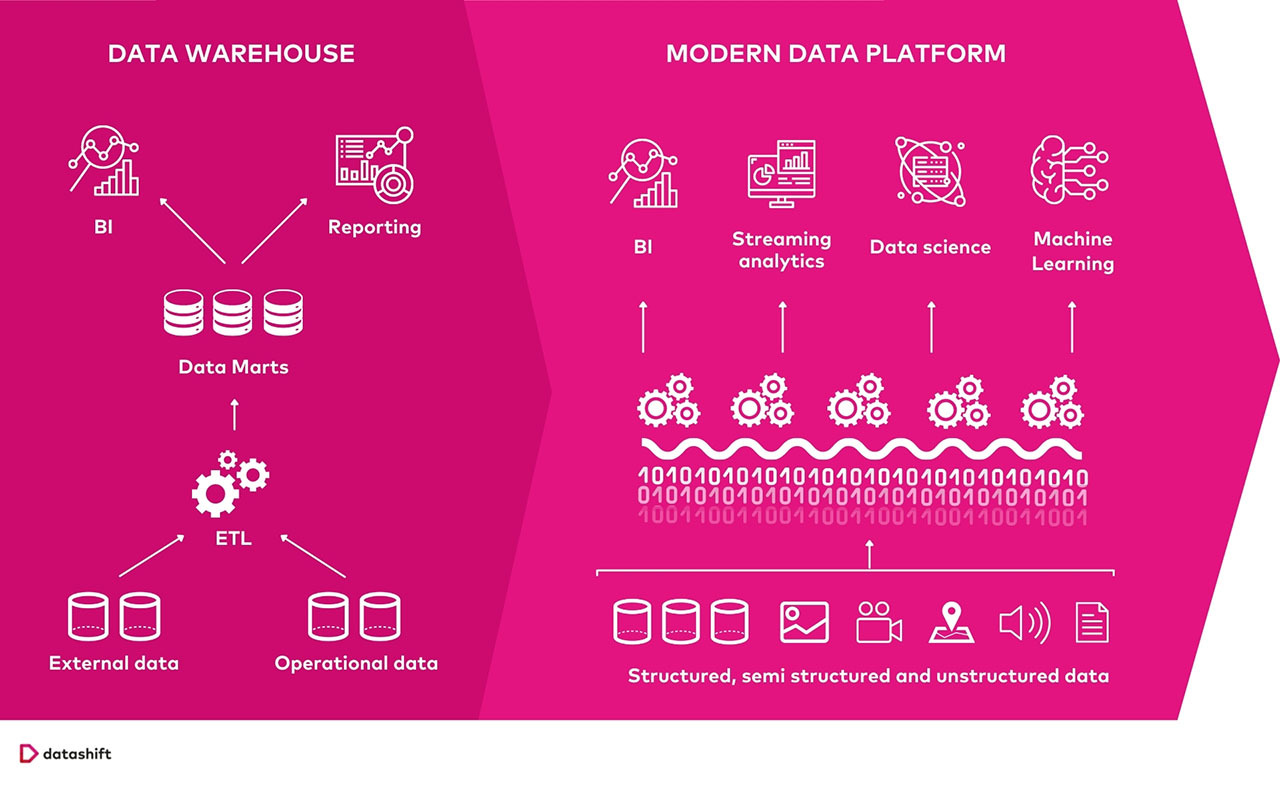Future-proof your business with a modern data platform
9 August 2021

As your business collects an ever-growing amount of data, the role of your data platform becomes increasingly important. To manage exponential data growth successfully and future-proof your business, you need a modern data platform that maximizes the value for your entire organization.
A platform enabled by cloud computing
The hardest part of building such a modern data platform is that it must provide a solution beyond today's requirements, preparing your business for future needs. Thanks to cloud computing, a "think once, execute" approach that binds you to a data architecture carved in stone, can now be a thing of the past. Instead, cloud computing enables you to implement a flexible and user-centric data platform that easily caters for the evolving needs of an expanding data consumer community.
And the great thing about this is that no significant upfront investment is required so that you can drastically reduce capital expenses. Instead, with a pay-per-use pricing model, you only pay for IT resources as you need them - allowing users and experts to experiment and iteratively extend your data platform with new components and applications.

Focused on creating end-user value
For a modern data platform to create actual business value, the needs of your end-user community must be central to the design. Focus on making the end-user successful, and everything else will follow.
Therefore, a modern data platform must be an open platform that integrates easily with the operational systems and applications that end-users are working with. But make no mistake: while the integration with your operational ERP or CRM systems is indispensable, it is by no means sufficient to future-proof your business.
If your marketing team needs to use clickstream data from your webshop to perform e-commerce analytics, for example, you must be able to integrate those clickstream data into the platform – and do it fast. Or, if your development team is looking into image recognition techniques to support an intelligent video surveillance system, it is essential that video data can be integrated into the platform and machine learning applications can be deployed easily.
Cloud computing makes it possible to build such an open data platform to integrate new data types and applications in a relatively short time. Thanks to the wide availability of various cloud services and the shorter lead times for implementation, you can respond faster to new user demands and create space within your organization to experiment with new applications – engaging end-users as much as possible.
Flexibility to cater for evolving end-user needs
Mapping your users' current data needs is one thing; predicting their future data needs is quite another. And yet, your data platform should have the flexibility to evolve with the needs of your data consumer community. So even if you don't know what questions you may need answers for in the future, your data platform should be ready for that.
What if you want to extend your current service portfolio with a subscription-based mobile app at some time in the future? Surely your data scientists will be looking to do machine learning on operational data from the app to build models that help you minimize customer churn. Or what if your product engineering team will need to process data streams from internet-connected devices to monitor and predict maintenance requirements? On a modern data platform built in the cloud, you can efficiently deal with such questions by adding new components or extending existing ones.

But that’s just one aspect of flexibility. A modern data platform must also be capable of providing an answer to future changes in the supply of data, both in terms of data volume, data variety, or speed. A modern data platform does not have to be foreseen for these changes in advance, but it must be able to switch quickly when necessary.
Expanding your data consumer community beyond BI
For quite a while, BI solutions have helped business users convert available data into easy-to-read dashboards. The classic data warehouse, a relational database that stores validated data from different source systems, is a crucial component of any BI environment. Traditionally, however, such a data warehouse has been an independent entity in the IT environment.
When building a modern data platform, a data warehouse can no longer be a stand-alone tool. Instead, it needs to become a part of the platform with for example a data lake serving as a centralized data hub in the cloud to which multiple types of users can connect – whatever the purpose they have in mind.
The data lake can be used as a source for your data warehouse so that business users can continue to create BI dashboards from validated operational data stored on the data platform. At the same time, however, such a data lake offers numerous new opportunities. For example, additional components can be plugged in with little effort to develop new data science, machine learning, or streaming analytics use cases – expanding your data consumer community beyond the existing BI user community.
You’ll find that data consumers are not only interested in new applications and use cases. They also want to be assured that data is transparent, high-quality, and reliable. A solid data governance strategy is crucial in this regard. It should, therefore, be an integral part of any modern data platform – focusing on cornerstone solutions to make data accessible, manage data ownership and ensure regulatory compliance.
Data Discovery at your fingertips
Users must be able to find, understand and trust the data they are looking for. A modern data platform provides off-the-shelf solutions to crawl, catalog, and index the data stored in your databases and data lakes automatically, collecting all relevant information with minimal effort to build a solid data management layer on the data platform.

As an inventory of your business' data - including descriptions, locations, and information about usage and context – such a data catalog makes the data accessible and understandable to whoever needs it for operational purposes, reporting, or analysis.
Roles and responsibilities
Various interventions such as strict modification, user access management, and automated quality controls help build trust in the data platform and, as a result, boost usage of the platform. And although such interventions are indispensable, they will not be sufficient by themselves.
To thoroughly solve data quality issues, you need to give data users and experts ownership and empower them to determine, solve, and prevent such problems by setting up the proper quality controls. Deploying a modern data platform can be an excellent opportunity to define roles and responsibilities within your data consumer community.
Regulatory compliance
As data governance helps ensure the quality and integrity of your data and makes these data more accessible, it will ultimately deliver more accurate analytics and enable better business decisions. However, regulatory aspects should also be covered by your data governance strategy. Since 25 May 2018, compliance with the harmonized EU General Data Protection Regulation (GDPR) is mandatory for any organization that processes personal data of EU citizens. Your data platform should, therefore, comply by design with the GDPR data protection rules.
How can we help?
As a Microsoft Azure and AWS partner, we’ve helped organizations in various markets develop a modern data platform in the cloud, including the migration of their existing on-premises data architecture into a cloud environment.
Are you curious to see how such a platform can strengthen your business as well? Don't hesitate to reach out to us for more info!
